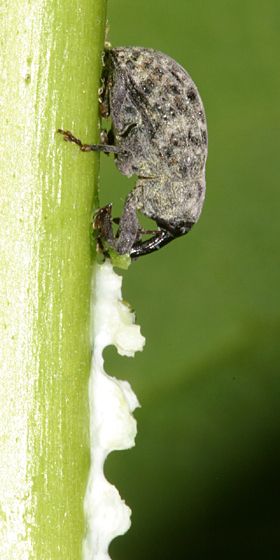
|
Return to Texas Entomology - Compiled by Mike Quinn

|
(Female)
Host: Asclepias syriaca
Biology:
Rhyssomatus lineaticollis primarily feed on the stems of Asclepias syriaca. Adults initially feed on the apical leaves and then, after feeding, female weevils walk to lower parts of the stem and chew several sequential holes in the stem, creating a continuous scar. Females lay a single egg per hole and larvae complete development inside the stem while feeding on pith tissue. Oviposition scar length is an accurate predictor of the number of eggs laid by the adult female. (Agrawal 2005)
Compared with other specialist insect herbivores on milkweeds, this curculionid beetle is unusual in that it is cryptically colored and does not sequester cardenolides characteristic of milkweed chemical defense (Fordyce & Malcolm, 2000).St. Pierre & Hendrix (2003) showed that R. lineaticollis is sedentary, with 50% of their recaptured beetles moving < 1 m and the maximum distance moved < 1 km.
Similar Species: There are 17 species of Rhyssomatus north of Mexico (Arnett et al., 2002).
Texas taxa:
Rhyssomatus fissilis Burke
Rhyssomatus grandicollis (Casey)
Rhyssomatus lineaticollis (Say)
Rhyssomatus ovalis (Casey)
Rhyssomatus palmacollis (Say)
Rhyssomatus parvulus (Casey)
Rhyssomatus pruinosus (Boheman)
Rhyssomatus pubescens Horn
Rhyssomatus rugulipennis Champion
Rhyssomatus texanus (Sleeper)
Photos:
Photos and Info - BugGuide
Rhyssomatus lineaticollis - Insects of Cedar Creek
Milkweed weevil - Rhyssomatus sp.
Milkweed weevil - Rhyssomatus sp.
Biography: Thomas Say (1787 – 1834) - Wikipedia
Agrawal, A.A. 2005. Natural selection on common milkweed (Asclepias syriaca) by a community of specialized insect herbivores. Evolutionary Ecology Research, 7: 651–667.
Agrawal, A.A. & P.A. Van Zandt. 2003. Ecological play in the coevolutionary theater: Genetic and environmental determinants of attack by a specialist weevil on milkweed. Journal of Ecology 91: 1049-1059.
Arnett, R.H., Jr., M.C. Thomas, P. E. Skelley & J.H. Frank. (editors). 2002. American Beetles, Volume II: Polyphaga: Scarabaeoidea through Curculionoidea. CRC Press. 861 pp.
Fordyce, J.A. & S.B. Malcolm. 2000. Specialist weevil, Rhyssomatus lineaticollis, does not spatially avoid cardenolide defenses of common milkweed by ovipositing into pith tissue. Journal of Chemical Ecology, 26: 2857–2874.
Nishio, S., M.S. Blum, S. Takahashi. 1983. Intraplant distribution of cardenolides in Asclepias humistrata (Asclepiadaceae), with additional notes on their fates in Tetraopes melanurus (Coleoptera: Cerambycidae) and Rhyssomatus lineaticollis (Coleoptera: Curculionidae). Memoirs of the College of Agriculture, Kyoto University 122: 43-52
Pierce W.D., 1913. Miscellaneous contributions to the knowledge of the weevils of the families Attelabidae and Brachyrhinidae. Proceedings of the United States National Museum 45: 365-426.
26 Jan 2009 © Mike Quinn / Texas Entomology / Texas Beetle Information